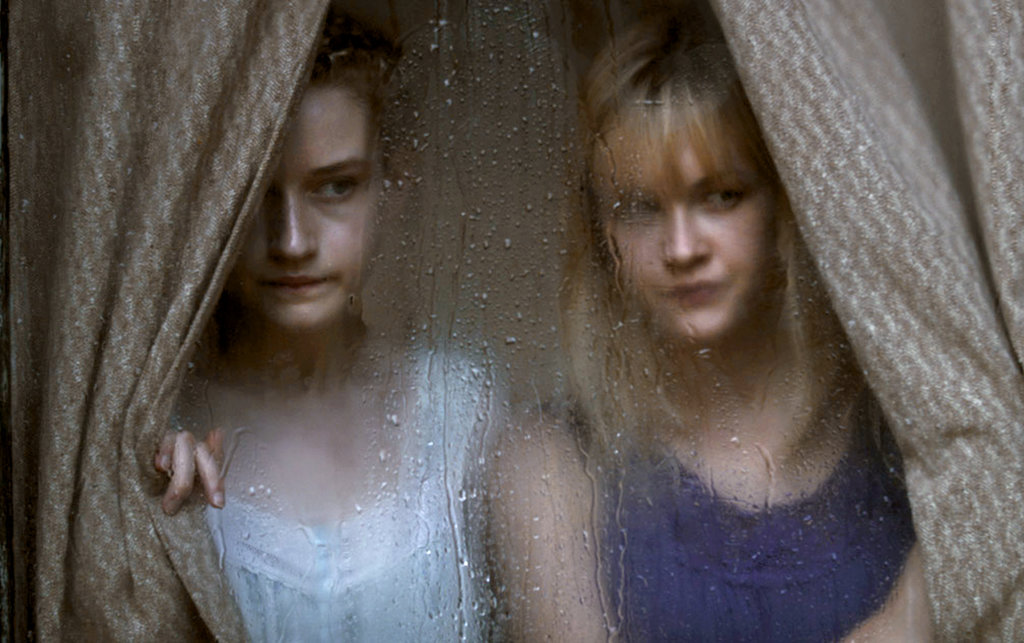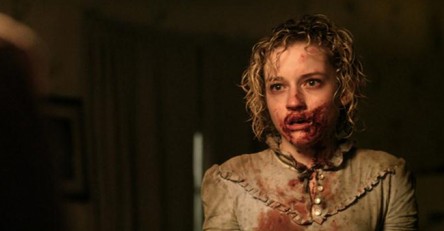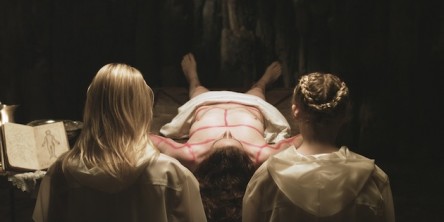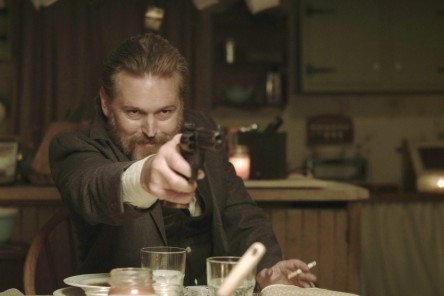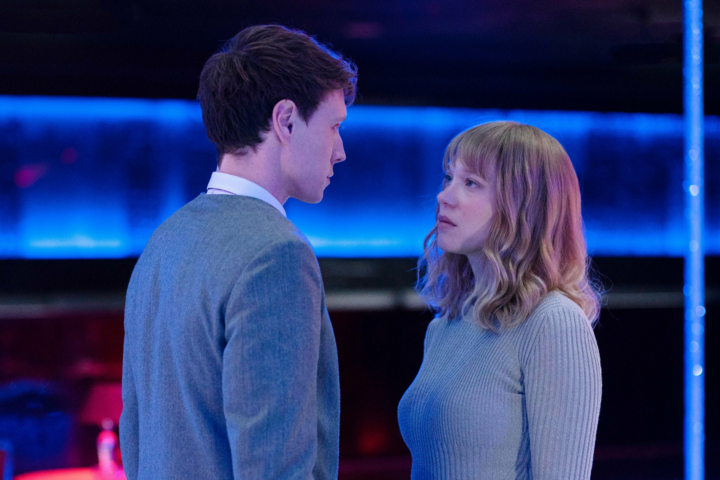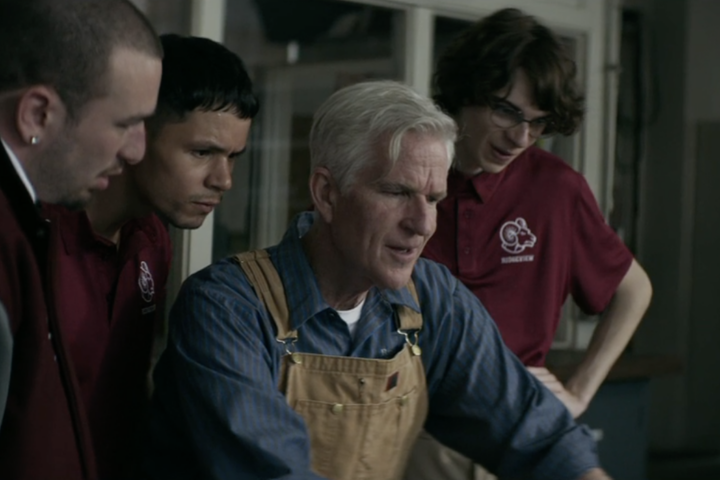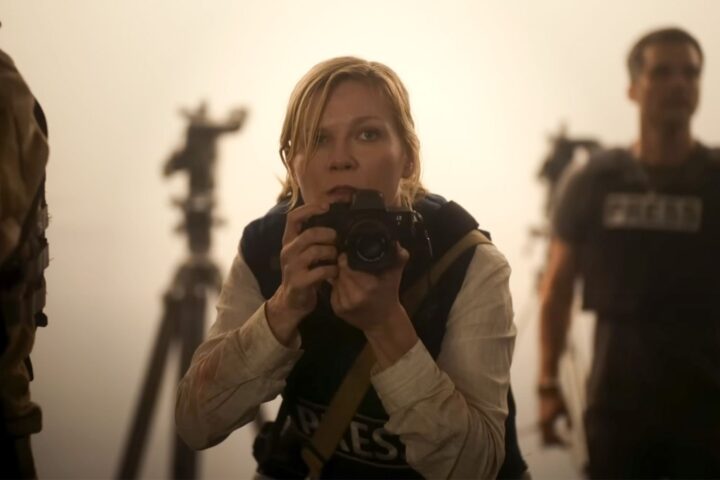Filmmaker Jim Mickle (Stake Land) wasn’t a fan of horror remakes, but something resonated in the 2010 Mexican cannibalism thriller Somos Lo Que Hay, the story of some gruesome family traditions and the ties (of blood) that bind.
With co-writer Nick Damici, Mickle refashioned the story into the new film We Are What We Are (opening in Chicago on October 11), a slow-burn tale of a small town, widowed father raising two teen daughters on the cusp of womanhood, who unbeknownst to themselves are about to come into their own and claim their birthright and family legacy, a very dark and twisted secret involving centuries of cannibalism.
Yet while the horror elements are present, the tonal and stylistic nods here are to the quiet, foreboding, atmospheric build of Guillermo del Toro’s canon, more about two delicate young women opening up to the world—a classic theme about exerting your personal identity away from your family—than about genre shocks.
Starring two terrific young actresses, Ambyr Childers and Julia Garner, as well as Boardwalk Empire’s Bill Sage as their conflicted father and with featured roles from the great Michael Parks and Kelly McGillis in a character turn, We Are What We Are is a movie about human nature—and the impossibility of reversing what’s in your blood. Oh, and a little about the joys of eating other people, bad as it might make decent folk feel in the moment.
I caught up with Jim Mickle recently to discuss the film’s themes and his balancing act of treating his teenaged characters with sensitivity in the midst of a horrifying milieu.
We Are What We Are is certainly a horrifying film, but not a horror genre pic in the traditional sense as the themes are a bit deeper—coming of age, loss of innocence, the sins of the fathers. There is also a strong current of nature throughout which is present from the opening shot of a spider in a web. It’s as if the film is saying that you cannot escape your true nature, right from the first scene.
Jim Mickle: Totally. I think a lot of it bubbles out of (co-writer) Nick Damici. A lot of it is feeling and instinct. It’s based on a real incident. We had a devastating hurricane come through that area the year before. It was like this beautiful place where you went to sleep with a little rain and woke up with it destroyed—a town that had been around for hundreds of years. That was so profound and random and we tried to acutely explore that here. We wanted to capture the delicate, beautiful side of nature and the brutal, do what it needs to survive and you can’t stop it. You don’t always necessarily know exactly what is going on with the girls, but that comes through.
There’s an unmistakable indictment of religious extremism here; the film clearly states that anyone can make up a religion based on whatever rules suit them and command a following.
JM: Exactly that. I think it’s terrifying. When you are making a horror movie you have to find something that scares the hell out of you, and that to me is the scariest thing. That it could be harmless and sweet but also horrifyingly manipulative.
Did you grow up in a religious household?
JM: No. My parents were more like, “Make your own decisions and think of it as a philosophy.” But my mom’s side was very religious and I grew up in a Pennsylvania Dutch area, so there is always this sense around you and that also comes through in my movies.
Ambyr Childers, who plays Iris in the film, was raised a Mormon. And she remarked that she knew the world of this film very well.
JM: Yes. I love that she worded it that way. I saw an audition tape of her and thought she was amazing and when I looked her up and saw a Mormon background, I Skyped with her and she said she could really relate.
The daughters have very much been kept in the dark about the secrets of their lineage. It reminded me of how disconnected we are today from knowing much about our grandparents and even before. We seem to have lost touch with some of this family legacy stuff in today’s society.
JM: Yes, I think that is fascinating. And it was one of things that Jorge (Michel Grau, director of Mexico’s original) explained to me was that people are out of touch with religion; they have blind faith but no one can explain why they do things, and I thought that was a really interesting idea. If aliens were to come down and you had to explain why we do some of the things we do, we would say, “Wow, this is really f**king crazy!”
Unlike many horror films, this one doesn’t have clear-cut villains. Even Bill Sage’s father character, Frank, is really a man trying to protect his daughters and maintain his family.
Yes. We never talked about Frank in horror terms, but rather as a dad who lost his wife and was trying to raise teen girls without knowing how. And that was something he could relate to—I’ll avoid saying sink his teeth into. But he could relate to that part and did a fantastic job.
It was great to see Michael Parks here as well, unraveling the mystery. In a way, he is very much like Frank in that he is searching for his daughter and his main concern is her well being; the symmetry worked.
JM: Yes, I always thought they were mirror images. In the first draft of the film, we shot a scene where his wife dies as well, and to me it was great because it gave the narrative mirroring. But in reality it was too much to throw in. Michael brilliantly thought it was too much but said he would play it and he did beautifully. We didn’t use it. It was something to me that took away from it. By the end of the movie, Michael had sold it anyway.
I absolutely loved the shot of lipstick drawing on flesh. It’s subtle and creepy and a terrific metaphor for the innocence that has just been stripped.
JM: Yes, originally it was how you might expect—a whole scene where it was gory and you could come up with any number of things that (the family) would have created over the years to butcher a body. It was fun, but it felt dishonest with the movie and was veering into expected horror things. The fun up until then was that we were able to tell the story of two girls and a father, and we felt that going in that direction was cheating the characters. We wanted to make it as delicate and sweet as possible and have them show respect for the body.
There’s a striking image of the girls in the shower that directly follows.
JM: That was the image- you have images in your head and that was one of them.
Do you sometimes come up with an image and then find a way to include in the story?
JM: Sometimes, yes! When I write on my own that is what happens! It’s just director ideas for shots and scenes. And then Nick is an actor first and foremost, so he is always thinking that if he was going to play the character how would it work. So we meet in the middle.
Great to see Kelly McGillis here, a star who got sort of unfairly dismissed for a while but is now doing very strong character work. I’ll always love her performances in Witness and The Accused. She really digs in here.
JM: I think she is more on her game than she ever was. I don’t think she was ever really comfortable with that era of who she was. She didn’t want to be a sex symbol and was forced into that. I think what is great about her now is that I think she has been through all of that, and is at a spot where she is really comfortable. I think now she is at a point where she has no filter and is not trying to impress anybody and it comes through in her acting; the mask is not there.
There is a very measured technique on display here. By that I mean a uniquely calibrated color palette, which is very restrained or desaturated, and a lush, full score. Would you give me a sense of the approach to both?
JM: Sure. This is my first time working with our production designer, Russell Barnes, who brought a really interesting way of looking at things. It was not just the color palette but the textures as well. I think it was all about not doing the “hard” thing and treating it as (the world of) two of the most fragile girls on the planet. Everything would be delicate—the fabrics, etc. I also don’t like modernity in movies; I think it is boring to look at. So we made everything look like it could be part of any decade.
Then it will never be dated.
JM: Yes. Cell phones do come up, but they are old cell phones. And then music really was two composers. I started working with Jeff Grace on Strange Land. I gave him the script and said, “This is where we are going.” It was cool to bring him in at the same time as the cinematographer and production and costume designers. It was great for the four of them to work as a team. He wrote a couple themes early on which I played on set a lot, like when there was a quiet scene with the girls that didn’t have dialogue. My sister production designed Drive and Only God Forgives, and I went to Thailand to visit on set. Nicolas (Winding Refn) had all of these really great 70s, psychedelic, quasi-soundtrack things going on. He was playing that during all of those dolly shots. I thought it was a great technique. At some point, Jeff’s schedule got crunched and we brought in Phil Mossman who had a completely different style from Jeff. He handled the darker, crazier stuff. I was terrified because of these two very different sounds, but hopefully we did a good job of marrying them.
There’s a terrific dungeon set here also, really a classic horror film setting.
JM: Originally it was stone and we had this earthy feeling. And then going back to our natural palette of things that grow and die… I hate the horror clichés of green, flickering fluorescent light and stuff. I loved that we had this kind of fairy tale feel behind it.
What’s the best part of your job?
JM: Editing. Shooting is stressful. Writing is good but it’s painful. But editing I love. I love sitting in a dark room; it’s cathartic after the chaos on a set, which is a long, hard, not enjoyable process. But then I love going into a dark room and sitting there with the footage and being able to shape the film and take it into any direction that you want to. You can do it the way that it would traditionally be done and then go back and find another way too. You can have any tone.
Special thanks to Jim Mickle for this interview.
